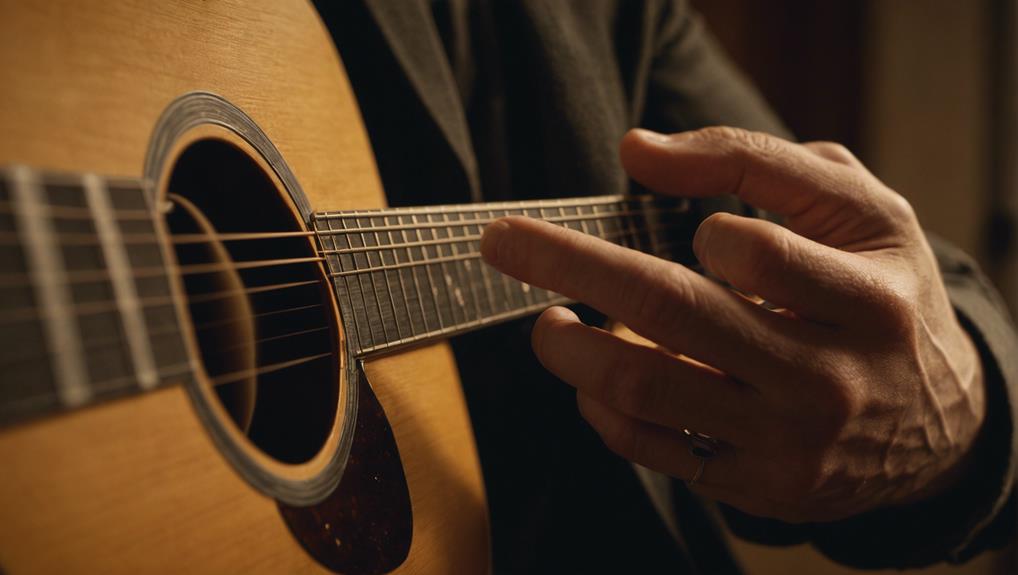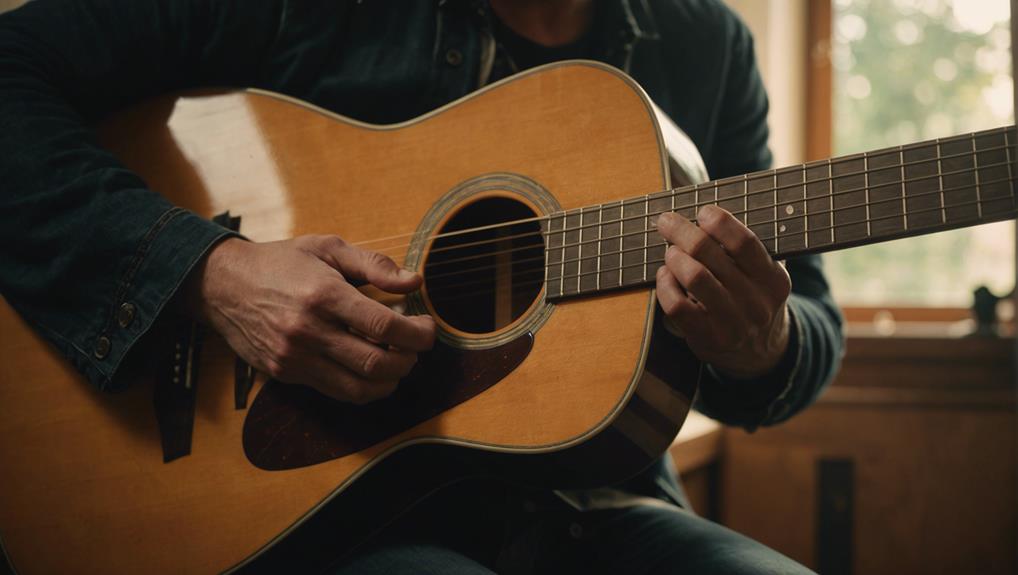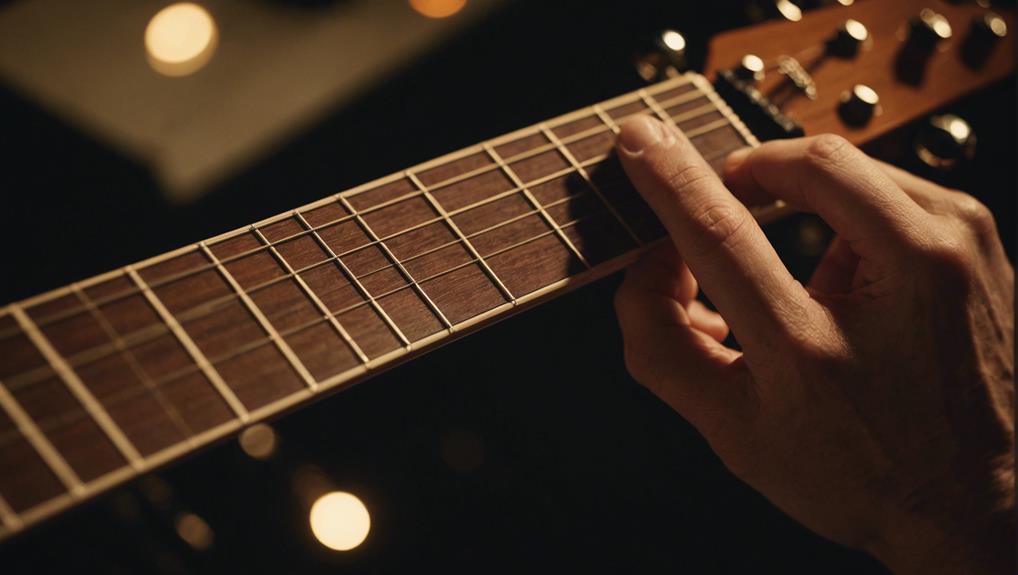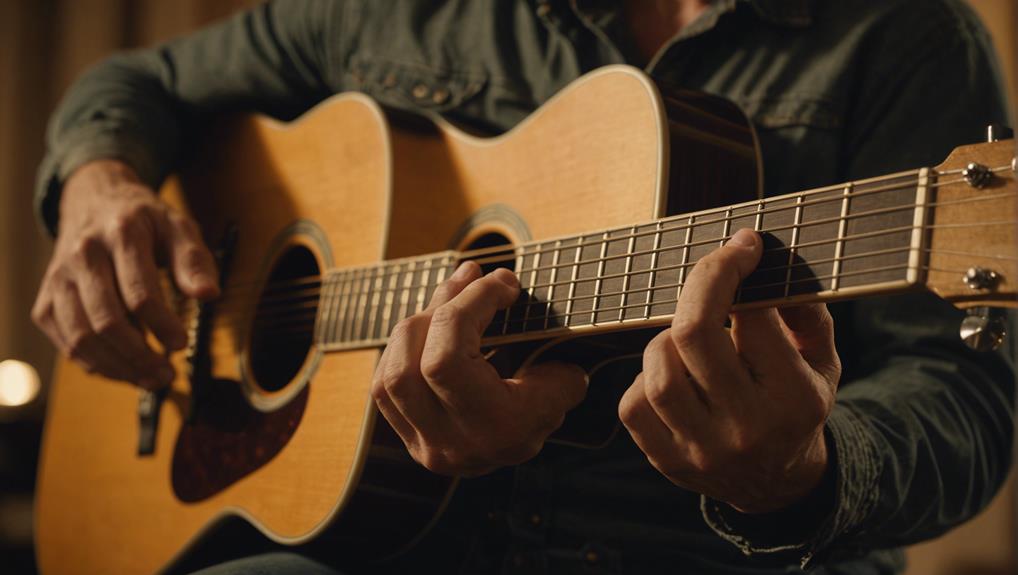When you’re just starting to learn guitar, mastering basic chords can seem intimidating, but it’s an essential step. You’ll begin with chords like E Major and A Major, which will help you build muscle memory and finger dexterity.
These foundational chords are vital for moving smoothly between different chords and improving your overall technique. Once you feel comfortable with these, you’ll notice your strumming patterns and versatility across various genres start to improve.
Are you ready to open the door to endless musical possibilities and take your guitar playing to the next level? Let’s explore how.
TL-DR
- Master E Major, A Major, D Major, G Major, and C Major chords as essential building blocks for beginners.
- Practice finger placement and transitions to ensure chord clarity and smooth playing.
- Utilize simple chords like E Minor and A Minor to build finger dexterity and versatility.
- Experiment with various strumming patterns to enhance musical expression and rhythm.
- Incorporate basic chords into different genres to develop a diverse and adaptable playing style.
E Major Chord
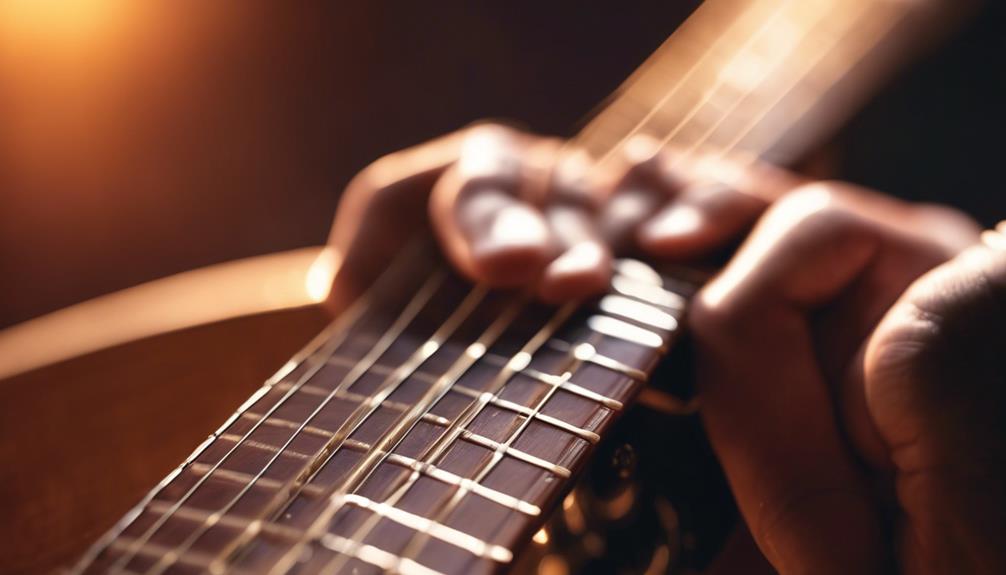
The E major chord is a must-learn for any beginner guitarist because of its frequent use in various music genres. To play the E major chord, place your index finger on the 1st fret of the G string, your middle finger on the 2nd fret of the A string, and your ring finger on the 2nd fret of the D string. Strum all six strings to make sure a full, clear sound.
This chord is fundamental, and mastering it will establish a strong foundation for your guitar playing journey.
When you’re starting out, practicing the E major chord will help you build essential muscle memory. Try changing between this chord and other basic chords to enhance your chord changes.
Focus on keeping your fingers arched and pressing down firmly to avoid any muted or buzzing strings.
A Major Chord
To play the A major chord, place your index, middle, and ring fingers on the 2nd fret of the D, G, and B strings, respectively.
Strum all five strings from the A string and you’ll hear a bright, full sound.
Focus on finger placement tips, strumming patterns, and its common uses in songs to master this essential chord.
Finger Placement Tips
When you’re learning the A Major chord, start by placing your index finger on the 2nd fret of the D string. This is one of the essential chords for beginners, so it’s important to get your finger placements right.
Next, take your middle finger and place it on the 2nd fret of the G string. Finally, position your ring finger on the 2nd fret of the B string.
Make sure all three fingers are as close to the fret as possible without actually being on top of it. This helps to minimize any buzzing or muted sounds that can occur if the strings aren’t pressed down properly.
Once your fingers are in place, strum from the A string down to the high E string. The low E string shouldn’t be played. Practice strumming slowly at first, listening carefully to confirm each note rings out clearly. If any notes sound muted or buzzy, adjust your fingers slightly and try again.
Repetition is key here. Spend a few minutes each day practicing this chord to develop muscle memory. With consistent practice, your A Major chord will sound clean and strong, setting a solid foundation for learning more chords.
Strumming Pattern Guide
Mastering the strumming pattern for the A Major chord starts with a simple down-up motion. As a beginner, you’ll find that starting with this basic pattern helps you build a solid foundation.
Begin by practicing a down strum followed by an up strum for each beat. This down-up motion is essential for maintaining a steady rhythm, important for playing Major Chords effectively.
Focus on keeping your strumming hand relaxed and fluid. Consistent practice will help you develop muscle memory, making it easier to play the A Major chord smoothly.
Once you’re comfortable with the basic pattern, try adding some variations. For instance, you can accentuate certain strums to add dynamics and make your playing more expressive.
Experimenting with these variations will enhance your overall strumming technique.
Another key aspect is shifting smoothly between the A Major chord and other chords. Practicing these changes will greatly improve your guitar skills and make your playing sound more cohesive.
Common Song Uses
You’ll find the A major chord featured prominently in many classic songs, making it a must-learn for any aspiring guitarist. One of the notable examples is ‘Sweet Home Alabama‘ by Lynyrd Skynyrd, where the A major chord plays an important role in the song’s progression. Learning this chord not only gives you the ability to play such iconic tunes but also lays the foundation for exploring various music genres.
The A major chord is fundamental for beginners because it’s prevalent in countless songs. Mastering chords A, like the A major, helps you develop finger strength and dexterity, which are essential skills for any guitarist. Practicing this chord allows you to shift smoothly between different chords, enhancing your overall playing skills.
D Major Chord
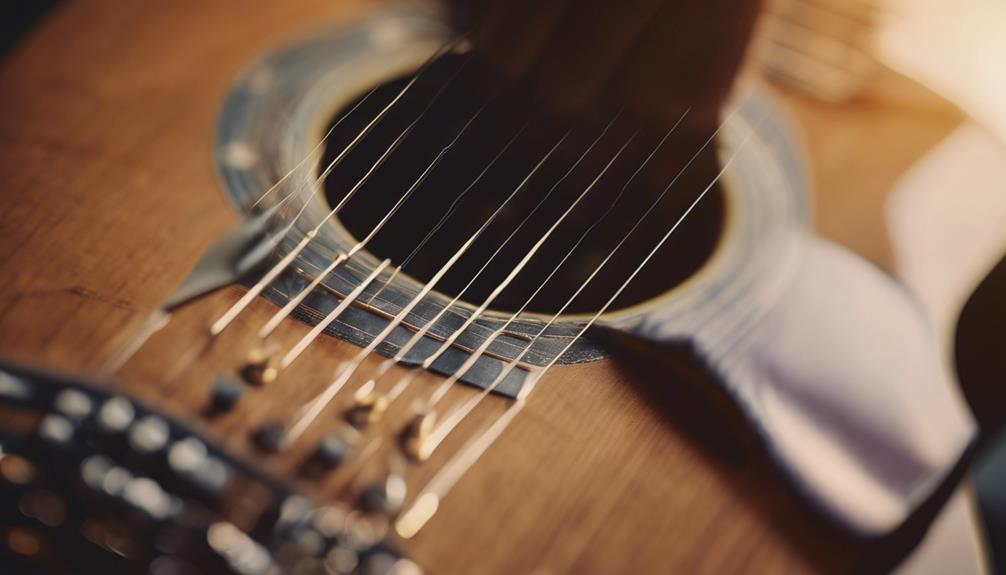
To master the D major chord, follow these steps:
- Start by placing your index finger on the 2nd fret of the G string,
- Place your ring finger on the 3rd fret of the B string,
- And place your middle finger on the 2nd fret of the high E string.
When strumming, focus on the D, G, B, and high E strings, avoiding the low E string.
Practice shifting smoothly from D major to other common chords like A major and G major.
Finger Placement Guide
When playing the D major chord, always start by placing your index finger on the 2nd fret of the G string. This creates the foundational note for the chord.
Next, position your middle finger on the 2nd fret of the high E string. This note adds to the beautiful harmony of the D major chord.
Finally, place your ring finger on the 3rd fret of the B string. Together, these finger placements form the complete D major chord.
To guarantee a clean sound, strum only the bottom four strings. Avoid hitting the low E and A strings, as they can muddy the chord’s clarity. It might take some practice to consistently strum the correct strings, but it’s essential for a crisp D major chord.
As you practice, focus on smooth shifts between the D major chord and other beginner chords like G and A. This will help you build proficiency and muscle memory, making it easier to play songs seamlessly.
Keep your thumb positioned at the back of the guitar neck for better control and comfort. With consistent practice, your D major chord will sound clear and bright, enhancing your overall guitar playing skills.
Strumming Pattern Tips
Start with a simple downstroke to emphasize the full sound of the D major chord. By strumming downward, you highlight the rich tones that make this chord resonate so beautifully.
Next, add some upstroke strumming to introduce dynamics and variety. A balanced mix of downstrokes and upstrokes will make your playing more engaging and lively.
Experiment with different strumming patterns to see what fits best. Try combinations like down-up-down or down-down-up. Each pattern brings a unique rhythm to your chord progression, so don’t be afraid to mix it up. The key is to find a pattern that complements the D major chord and enhances your overall sound.
Consistency is essential when it comes to strumming technique. Keep your timing steady to maintain a smooth flow, especially when you’re shifting between chords. A consistent strumming pattern will make your music sound polished and professional.
Lastly, practice is your best friend. Spend time switching between the D major chord and other chords. This will improve your muscle memory and make your changes seamless. With dedication, your strumming patterns will become second nature, elevating your guitar playing to new heights.
Common Transition Chords
Moving seamlessly between chords is crucial for creating fluid and harmonious guitar playing. One of the chords you must master early on is the D major chord. It’s a staple in many songs and is relatively simple to play, making it perfect for beginners.
To form the D major chord, place your index finger on the 2nd fret of the G string, your middle finger on the 2nd fret of the high E string, and your ring finger on the 3rd fret of the B string. When strumming, focus on the top four strings and avoid the low E string to achieve the proper sound.
Shifting to and from the D major chord is essential for improving your overall chord changes. Spend time practicing moving to the D major chord from other common chords like G, A, and E minor. This practice will enhance your playing skills and make your transitions smoother.
Mastering the D major chord opens up a range of songs and chord progressions. Whether you’re playing folk, rock, or pop, you’ll find the D major chord invaluable.
Keep practicing these movements, and you’ll notice a significant improvement in your guitar playing.
G Major Chord
Learning to play the G major chord is important for any beginner guitarist, as it lays the foundation for countless songs and seamless chord changes. Beginner guitar chords like the G major are essential because they’re frequently used and provide a great starting point for building your skills.
To play the G major chord, place your index finger on the 2nd fret of the A string, your middle finger on the 3rd fret of the low E string, and your ring finger on the 3rd fret of the high E string. Once your fingers are positioned correctly, strum all six strings to produce the chord’s clear and resonant sound. This chord is versatile and appears in various songs across different genres, making it an indispensable part of your guitar journey.
Mastering the G major chord not only enables you to play a wide array of songs but also helps improve your overall guitar playing skills. It’s important to understand the finger positions and proper strumming technique, as this will ensure you play the chord accurately and confidently.
As you practice, you’ll find that switching smoothly between chords becomes more intuitive, making your playing sound more polished and professional.
C Major Chord
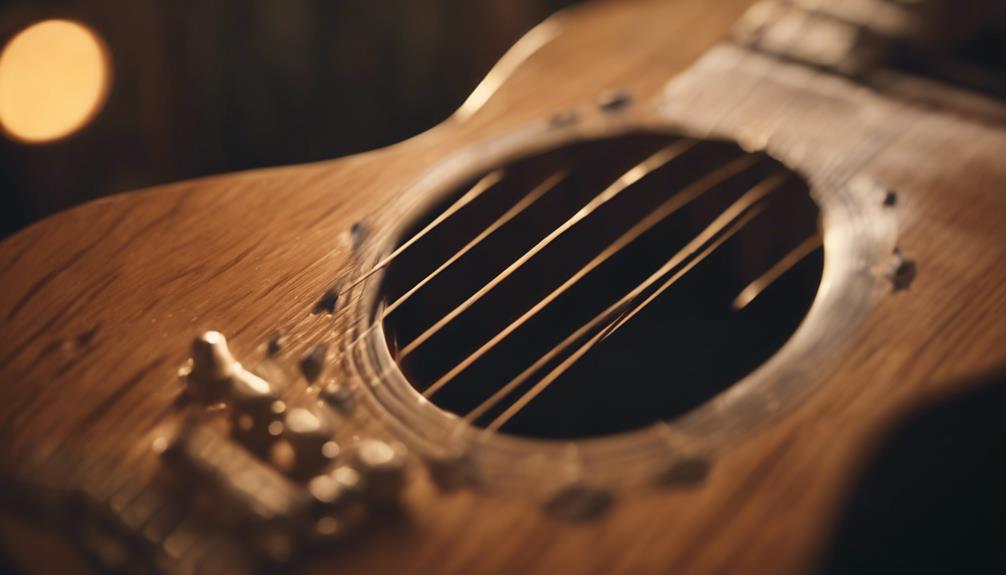
After mastering the G major chord, it’s time to learn the C major chord, another fundamental chord every beginner guitarist should know. The C major chord uses three fingers on the guitar neck and is essential for many songs. A typical chord diagram shows you how to position your fingers correctly.
To play the C major chord, place your ring finger on the 3rd fret of the A string. Next, position your middle finger on the 2nd fret of the D string. Finally, put your index finger on the 1st fret of the B string. When strumming, start from the A string and avoid the low E string to produce a clear, harmonious sound.
The C major chord is versatile and serves as a building block for more complex chord progressions. It’s commonly used in a wide range of songs, making it a must-know for any aspiring guitarist.
Practice switching smoothly between the C major chord and other basic chords to enhance your playing skills. Consistent practice will help you switch chords effortlessly, improving your overall performance. Keep practicing, and soon you’ll find the C major chord becoming second nature.
E Minor Chord
Ready to deepen your guitar skills, you’ll find the E minor chord both simple and vital. As one of the essential beginner chords, the E minor chord consists of the notes E, G, and B. This chord’s structure makes it a minor triad, giving it a melancholic or somber sound that you’ll often hear in rock, pop, and folk music.
To play the E minor chord, place your index finger on the 2nd fret of the A string. Make sure you’re pressing down firmly to get a clear sound. Then, strum all six strings. Yes, it’s that straightforward! This ease of play is one reason why the E minor chord is a favorite among beginners.
Mastering the E minor chord is vital for expanding your chord repertoire. With it, you can play a wide range of songs and progressions. It’s a versatile chord that fits seamlessly into many musical genres. By mastering this chord, you’re setting a solid foundation for your guitar journey.
Incorporating the E minor chord into your practice sessions won’t only improve your skill but also your confidence. It’s a small step with a big impact, making it an essential part of your early guitar learning experience.
A Minor Chord
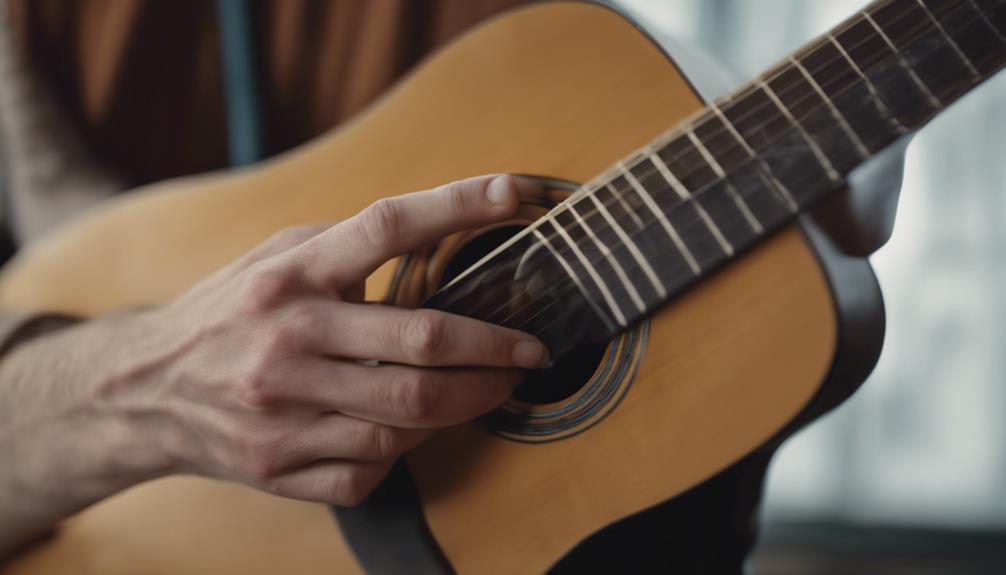
To play the A minor chord, place your index finger on the 1st fret of the B string, and strum all the strings for a rich sound.
This chord is a staple in many songs across different genres.
Practice switching between A minor and other chords to enhance your playing skills.
Finger Placement Guide
When playing the A minor chord, start by placing your index finger on the 1st fret of the B string. This is the first step in forming the A minor chord.
Next, position your middle finger on the 2nd fret of the D string, ensuring it presses down firmly.
Following this, place your ring finger on the 2nd fret of the G string. This finger placement is important for achieving the correct sound.
Once your fingers are correctly positioned, strum from the A string down. This means you’ll be playing the A, D, G, B, and high E strings, but not the low E string.
The A minor chord should resonate with a rich and somber tone, characteristic of minor chords. Make sure each string rings out clearly without any buzzing or muted notes.
To master the A minor chord, it’s essential to practice switching smoothly between it and other beginner chords, such as C major or E major. This will improve your finger dexterity and overall playing proficiency.
Keep practicing, and you’ll find that moving between chords becomes more fluid and natural over time.
Common Song Uses
You’ll find the A minor chord featured in numerous iconic songs across genres, making it a versatile and essential chord for any beginner guitarist. The A minor chord’s melancholic and emotional sound is crafted from the notes A, C, and E. Its simplicity means you can easily play it using just three fingers on the guitar neck, providing a great starting point for your musical journey.
Many classic tunes leverage the A minor chord to explore a range of emotions. For instance, ‘Stairway to Heaven’ by Led Zeppelin and ‘Horse with No Name’ by America feature the A minor chord prominently. Mastering this chord allows you to investigate an array of songs, helping you practice and refine your skills.
Here are some reasons why the A minor chord is a must-know:
- Emotional Expression: Its melancholic tone adds depth to any song.
- Simplicity: Easy to learn and play, ideal for beginners.
- Genre Versatility: Used across rock, pop, and folk music.
- Song Variety: Opens up many song options for practice.
- Foundation for Progression: Serves as a stepping stone for learning more complex chords.
D Minor Chord
Mastering the D minor chord will add a touch of melancholy to your guitar playing with its rich, emotional tones. The D minor chord is composed of the notes D, F, and A, creating a sound that’s both haunting and beautiful.
To play this chord, place your index finger on the 1st fret of the high E string, your middle finger on the 2nd fret of the G string, and your ring finger on the 3rd fret of the B string.
This simple yet evocative chord is prevalent in various music genres, including folk, rock, and blues. It’s versatile and can add depth and emotion to your songs, enhancing your overall musical experience.
When you first start practicing, it might feel a bit tricky to get all your fingers in the right place. Don’t worry; with consistent practice, you’ll build muscle memory, making movements smoother over time.
Try incorporating the D minor chord into your playing by practicing chord changes. Move between D minor and other basic chords, like C major or A minor, to get comfortable with the motion. This won’t only improve your technical skills but also make your playing more fluid and expressive.
G Major 7th Chord
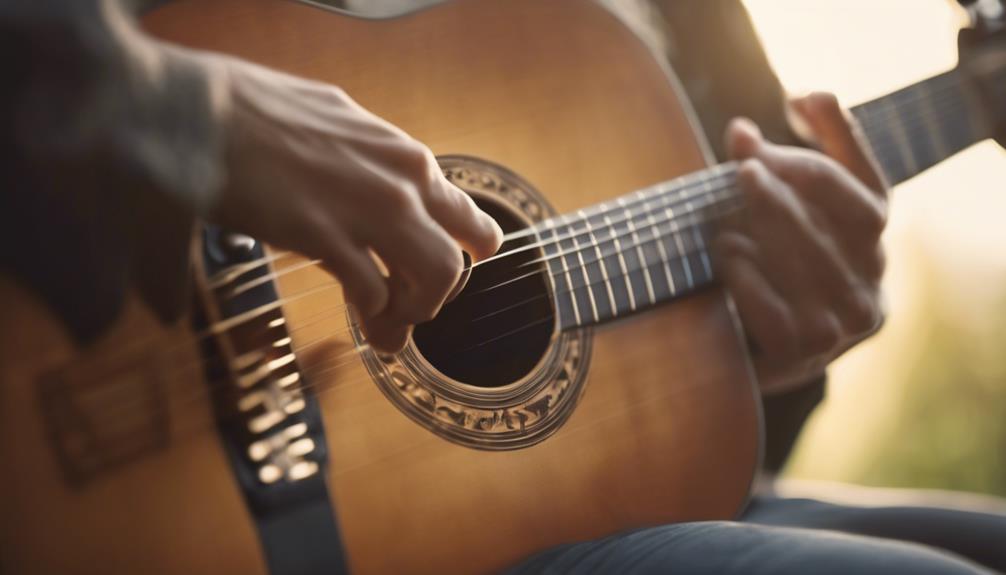
Adding the G Major 7th chord to your repertoire introduces a jazzy and sophisticated sound to your music. This chord is a fantastic addition, especially if you’re looking to branch out into genres like jazz, funk, or R&B.
The G Major 7th chord consists of the notes G, B, D, and F. To play it on the guitar, you’ll need to place your fingers as follows: 3rd fret of the low E string, 2nd fret of the A string, 4th fret of the D string, and 3rd fret of the high E string.
Here are some key points to keep in mind:
- Finger Placement: Make sure each finger is correctly positioned to avoid muting other strings.
- Practice Shifts: Regularly practice moving to and from the G Major 7th chord to enhance your fluidity.
- Strumming Patterns: Experiment with different strumming styles to bring out the chord’s unique sound.
- Music Genres: Incorporate this chord into jazz, funk, and R&B to elevate your musical versatility.
- Chord Progressions: Use the G Major 7th in various chord progressions to understand its harmonic role.
A Dominant 7th Chord
To play the A Dominant 7th chord, position your fingers on the 2nd fret of the D, B, and G strings. Place your index finger on the 2nd fret of the D string, your middle finger on the 2nd fret of the B string, and your ring finger on the 2nd fret of the G string. This chord, often referred to as A7, includes the notes A, C#, E, and G, giving it a distinctive bluesy and jazzy sound.
When you strum the A7 chord, focus on the middle four strings (D, G, B, and high E strings) to achieve a clear and resonant sound. This open chord is commonly used in various music genres, adding tension and leading to satisfying resolutions in chord progressions.
To improve your playing skills, practice moving to and from the A7 chord. This won’t only enhance your chord changes but also increase your musical versatility.
Try incorporating the A7 chord into different songs and progressions to get a feel for its unique sound and how it complements other chords. Mastering the A7 chord will add a rich, dynamic element to your guitar playing repertoire.
E Minor 7th Chord
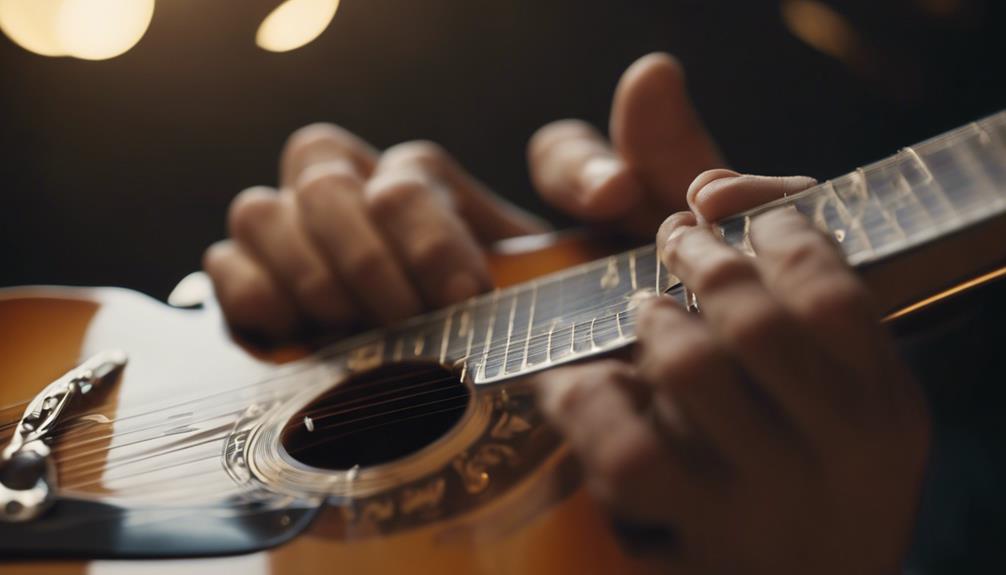
After exploring the vibrant A Dominant 7th chord, let’s move on to the mellow and versatile E Minor 7th chord. This chord is a staple in jazz, blues, and funk music, adding a rich, jazzy feel to your playing.
The E Minor 7th chord consists of the notes E, G, B, and D, and it’s a great chord to introduce more complexity into your music.
To play the E Minor 7th chord, place your fingers on the 2nd fret of the A string and the 3rd fret of the B string. Let the open E string ring out to give the chord its full, resonant sound. Here’s a quick breakdown to help you understand and practice this chord:
- Open E string: Let it ring for depth and resonance.
- 2nd fret of the A string: Use your middle finger for smooth shifts.
- 3rd fret of the B string: Place your ring finger here for a fuller sound.
- G string: Leave it open for added richness.
- E Minor 7th chord: Adds a mellow, jazzy touch to progressions.
Practicing the E Minor 7th chord not only enriches your sound but also helps improve your overall guitar skills by facilitating smooth shifts between chords. Enjoy experimenting with this versatile chord!
Power Chords Basics
Power chords are a fundamental building block for any beginner guitarist looking to play rock and modern music. They shine in their simplicity, focusing on just two or three strings and frets, making them easier to play compared to many other chords. Due to their straightforward structure, power chords are an excellent starting point for those new to the guitar.
Primarily used on electric guitars, power chords can be greatly enhanced with distortion, giving you that rich, full sound often heard in rock tracks. This makes them perfect for anyone enthusiastic to immerse themselves in playing heavier music genres. Unlike open chords, power chords don’t include as many notes, which makes them less complicated and quicker to master. You’ll find that their simplicity doesn’t sacrifice any of their powerful impact.
Additionally, learning power chords sets a solid foundation for progressing to more complex chord forms like barre chords. Barre chords require pressing down multiple strings across a single fret, a technique that can initially be challenging. However, mastering power chords will give you the finger strength and dexterity needed to tackle barre chords with confidence.
Suspended Chords
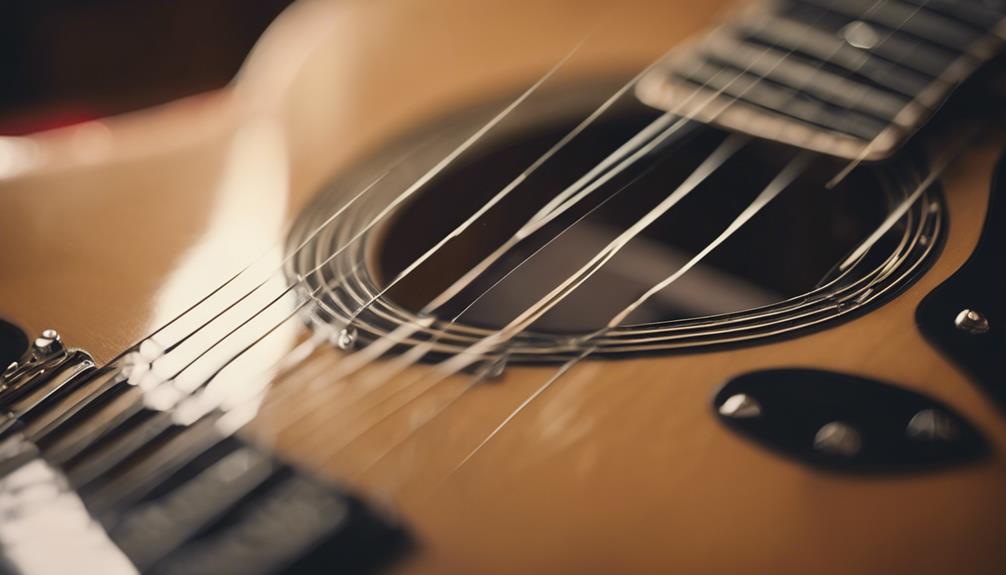
Suspended chords, like Esus4 and Asus2, add a unique tension to your music by replacing the third with the fourth or second note.
These chords can create smooth shifts and enhance the anticipation or resolution in your songs.
Incorporating suspended chords into your playing will expand your chord vocabulary and boost your musical expression.
Common Suspended Chords
Suspended chords, often referred to as sus chords, inject both tension and a unique sound into your music. For beginner guitarists, learning these chords can greatly enhance your playing by adding a layer of complexity and emotion.
Common suspended chords such as Esus4, Asus2, Dsus4, Gsus4, and Csus2 are often used to create a sense of anticipation in a song’s progression. These chords replace the third of a major or minor chord, offering a distinct harmonic quality that’s both intriguing and versatile.
When you start incorporating sus chords into your practice, you’ll notice they can make even simple progressions sound richer. Here are some key points to explore:
- Esus4: This chord replaces the major third (G#) with the fourth (A), creating a bright, open sound.
- Asus2: By replacing the major third (C#) with the second (B), this chord sounds airy and unresolved.
- Dsus4: The major third (F#) is replaced with the fourth (G), adding a sense of tension.
- Gsus4: This chord swaps out the major third (B) for the fourth (C), giving it a powerful and dramatic feel.
- Csus2: By replacing the major third (E) with the second (D), it offers a gentle, suspended quality.
Experimenting with these chords will add depth and emotion to your playing, making even basic songs sound more sophisticated.
Transition Between Chords
Incorporating suspended chords into your chord progressions can make your music more dynamic and emotionally engaging. Suspended chords replace the third with either the second or fourth note of the scale, creating a sound filled with tension and anticipation.
Common suspended chords like Esus4, Asus2, Dsus4, Gsus4, and Csus2 each bring a unique tone and feel, which can add depth to your compositions.
Moving between suspended chords and other basic chords, such as major and minor chords, will enhance the allure of your song. For example, shifting from an E major chord to an Esus4 and then back to E major can create a captivating musical journey.
The sense of unresolved tension in suspended chords keeps the listener engaged, waiting for resolution.
To master these shifts, study chord diagrams carefully. Practice moving your fingers smoothly between positions, ensuring each note rings out clearly. This technique will expand your musical vocabulary and help you craft more interesting compositions.
Enhancing Musical Tension
By using sus chords, you can inject a compelling sense of tension and anticipation into your music. Suspended chords, or sus chords, temporarily replace the third with the fourth or second note, creating a unique tonal color. This subtle shift adds ambiguity and interest to your chord progressions, making your music more dynamic.
Here’s why you should explore sus chords in your playing:
- Tonal Variety: Chords like Esus4, Asus2, Dsus4, Gsus4, and Csus2 each bring a different harmonic effect, enriching your music.
- Versatility: Sus chords fit seamlessly into various genres, including rock, pop, and folk.
- Open String Use: Many sus chords can be played using open strings, making them easier to incorporate into your playing.
- Resolution: The tension in sus chords can be resolved back to major or minor chords, adding a satisfying dynamic to your compositions.
- Expressiveness: Including sus chords in your repertoire enhances your musicality, allowing for more creative and emotive expression.
To illustrate, try playing a Dsus4 (D-G-A) and then resolve it to a D major (D-F#-A). Notice how the tension resolves into a harmonious chord, creating a captivating musical journey.
Embrace sus chords to elevate your playing and captivate your audience.
Mastering Barre Chords
Barre chords, which require one finger to press down multiple strings, can greatly expand your playing repertoire once mastered. The most common shapes you’ll encounter are the E-shaped, A-shaped, and D-shaped barre chords.
For instance, an E-shaped barre chord can be shifted up and down the neck to create various major chords. This versatility means you can play complex songs in any key.
Mastering barre chords can be challenging for beginners. It takes time to build the necessary finger strength and develop the correct positioning. Start by practicing the E-shaped major barre chord, as it’s a foundational shape. Place your index finger across all six strings at a given fret, then form an E major shape with your other fingers.
Initially, you might experience some buzzing or muted strings, but don’t get discouraged. It’s all part of the learning process.
To improve, practice switching between barre chords and open chords. This will enhance your overall guitar skills and versatility. Use a metronome to keep a steady tempo and gradually increase the speed.
Consistent practice will lead to stronger fingers and cleaner chord switches, ultimately making you a more proficient guitarist.
Next up, learn about guitar scales in this guide.
